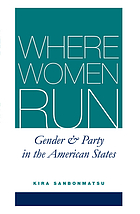
While studying women in Congress offers valuable insights about the role of women leaders in federal offices, researchers increasingly turn to studying women elected officials at the state and local levels as well. Since there are more women serving overall at the state level, researchers can analyze larger sample sizes. Additionally, with fifty state governments, research can examine the role that different institutional structures, political cultures, and other variables can play in shaping how women serve at the state level. Since Congress members and candidates previously served in the state legislature, it is important to study states in connection to congressional office. Like Congress, most state governments maintain accessible archives of voting, hearings, and other committee work. Many state legislators have websites and are active on social media, though not always with the same level of consistency as Congress members.
Sanbonmatsu studied sex and party politics at the state level. Based on elite interviews and survey data, she concluded that parties can actively encourage and discourage women candidates through recruitment patterns and networks. In Where Women Run: Gender and Party in the American States, Sanbonmatsu provided an in-depth comparative analysis of women running for state legislative office in six states, concluding that party recruitment techniques continued to serve as an important indicator of the level of women candidates and officeholders. Similarly, Laurel Elder examined why the number of female Democratic state legislators has increased, while the number of female Republican state legislators has decreased. Her analysis of state level party differences illustrated that the Democratic Party remains stronger in terms of recruiting and supporting female candidates (Elder 2012).
Becky Scola examined the intersections between race, ethnicity, and women serving in state legislatures, concluding that a negative relationship appears to exist between states with higher proportions of white women legislators and those with higher proportions of women of color legislators. States with higher levels of white women legislators tended to have lower levels of representation by women of color, and vice versa. She calls for further research to understand this relationship (Scola 2006). Nadia Brown’s book, Sisters in the Statehouse: Black Women and Legislative Decision Making, offers a broad overview of the intersections of race and sex in state legislative office. Her research uses elite interviews, participant observation, and a case study of legislative work on domestic violence to illustrate the complexities of leadership and power for black women legislators.
Some of the largest percentages of women serving can be found at the local level, especially school boards and city and county government offices. Numerous factors lead to this higher level of representation, including the fact that women are often primary caregivers in their families, and local offices may make the work-life balance easier. While researchers recognize the importance of studying local offices, this research can be more daunting, since access to records and data may be inconsistent. Nonetheless, research indicates that women serve in these local offices not to pursue higher political offices—that these are different types of offices altogether, and it is important for research to examine how women serve in these roles.
Daniel Shea and Rebecca Harris analyzed the connections between sex and local party leadership, based on a phone survey with party leaders. They concluded that women local party leaders are more ideological than their male counterparts, and are more focused on responsible party representation (Shea and Harris 2006). James Vanderleeuw, Maria Sandovici, and Christopher Jarmon analyzed the different policy perspectives of female and male city leaders. Their study of 150 city leaders in Texas examined the economic development priorities of men and women leaders. They concluded that sex does not matter in determining basic goals about jobs and economic growth, but women city leaders additionally focused on postmaterialist values, such as the environment and park systems (Vanderleeuw, Sandovici, and Jarmon 2011). Smith, Reingold, and Owens explored why some cities have higher levels of women’s representation in municipal government. They analyzed 239 large cities, and concluded that the presence of female mayors and female city council members had a positive relationship. The authors also find that the level of cohesion of women’s organizations, united in supporting women leaders, influenced the number of women leaders (Smith, Reingold, and Owens 2012).
 Where Women Run : Gender and Party in the American States by
Where Women Run : Gender and Party in the American States by